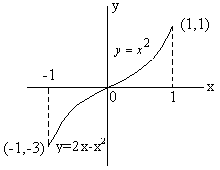8) A function is defined as follows,

Discuss continuity of f.
Solution:
Continuity at x = 0
L.H.L at x = 0 
R.H.L at x = 0 
f (0) = 1+Sin0 = 1
= L.H.L = R.H.L = f (0) so f (x) is continuous at x = 0.
Continuity at 
L.H.L at  =
= 
R.H.L at  =
= 

\ R.H.L = L.H.L = 
So, f(x) is continuous at  .
.
Hence f(x) is continuous over the whole real number.
9) Discuss the continuity of the function:
g (x) = [x] + [-x] at integral values of x.
Solution:
Here x can assume two values a) Integers b) Non-Integers
a) If x is an integer
[x] = x and [-x] = -x Þ g(x) = x-x = 0.
b) If x is not an integer.
Let x = n+f Where n is an integer and f Î (0, 1).
Þ [x] = [n+f] = n.
Þ [-x] = [-n-f] = [(-n-1) + (1-f)] = (-n-1). (Because 0<f<1 Þ (1-f) <1)
Hence g(x) = [x] + [-x] = n + (-n-1) = -1.
So we get;
g(x) = 0; if x is an integer
 = -1; if x is not an integer
= -1; if x is not an integer
Let us discuss the continuity of g(x) at a point x=a (Where a Î integer).
L.H.L =  (as x®a-, x is not an integer)
(as x®a-, x is not an integer)
R.H.L =  (as x®a+, x is not an integer)
(as x®a+, x is not an integer)
But g (a) = 0 because a is an integer.
Hence g(x) has a removable discontinuity at integral values of x
\ g (x) = [x] + [-x], xÏ integer.
= -1, x Î integer.
10) Let f(x) = x- |x-x2|, -1£ x £ 1. Discuss the continuity of f(x) in the closed interval
[-1, 1]. Draw the graph of f(x) in that interval.
Solution:
Here f(x) = x-|x (1-x)|
= x- |x| |x-1|, -1£ x £ 1.
Now using definition of modulus function we have


We know that polynomials are continuous every where, so only doubtful point is the turning point x=0 of definition.

So f(x) is continuous at x=0.
Hence f(x) is continuous in [-1, 1].
Hence the graph of f(x) is continuous in [-1, 1] and
f (x) = 2x-x2 in -1£ x < 0
x2 in 0£ x £ 1.
\ The graph of f(x) is as follows;

11) A function f(x) is defined by

Discuss the continuity of f(x) at x=1.
Solution:
We have


\ R.H.L at x2 =1
Þ 
Also L.H.L at x2=1
Þ 
 does not exist {as R.H.L ¹ L.H.L}
does not exist {as R.H.L ¹ L.H.L}
Hence f(x) is not continuous at x=1.